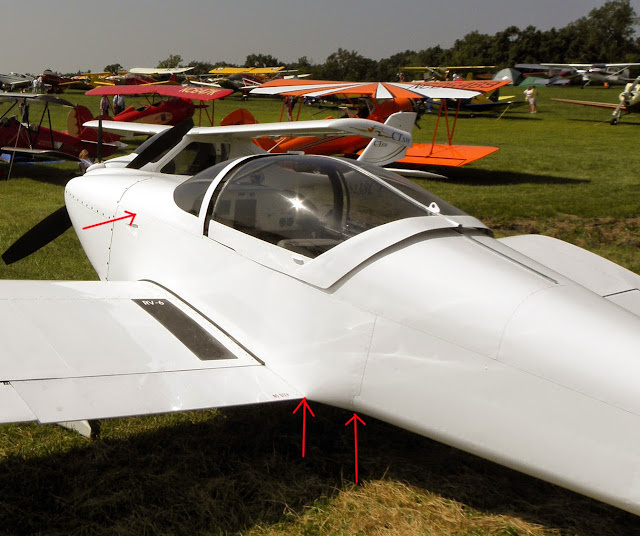Here's a couple of specific areas to look at in RV6 that will be a giveaway as to the rest of the aircraft's construction quality.
1) Look at the joint from the main forward fuselage to the aft fuselage, just rear of the aft spar (where the flap joins the fuselage). It goes from a square to a round shape. If there are no gaps at all and it's a nice, tight, rounded joint without a ton of spacers, gaps, fingers, of dents, then it's likely someone spent a good deal of time to get that joint correct. It's amazing how many good ones I've seen, but I've also seen one's where you could almost stick a pencil in the gaps.
2) Look at the most forward upper top fuselage skin and where it joins to the main longerons. if this joint has a very nice rounded appearance, is tight with no gaps, and doesn't show a crease, then it's also likely the person spend a good deal of time getting that correct. I've seen many good one's, but I've also seen them where it look like someone took a hammer and beat it to make it bend over the forward main longeron (usually not denoting a problem with the skin, but moreover that the builder likely didn't twist his longerons correctly).
3) If it's a Taildragger with a sliding canopy, see if the canopy will slide open on it's own. If so, then someone spend time to get that right aw well. Also, if it's a slider (regardless of nosewheel/TD), take a look at where the rollover bar attaches to the canopy deck rails. If the joint from the bottom of the rollover bar to the canopy deck rails and then the main spar carrythough looks good, symmetrical, no crazy extra rivets/bolts, then this likely is good. Also look a the canopy skins. A very well done canopy (sliding or tipper) will have the skins very tight, when latched, but still allow the canopy to open and close nicely. The latch operation themselves will also indicate some quality or lack therof.
4) Look at the spar carrythrough bulkhead on the sides of the fuselage itself (both inside and out) and see how those rivets are.
5) Look at the bottom of the fuselage where the forward main bottom skin (the thick one) joins the thinner skin aft of it. See how much the rivets are smoking and how well that joint was made. It goes from perfectly flat at the firewall to a "V" shape (the dihedral of the wing) right under the spar.
6) If it has the old tail, look carefully at the trailing edges and see if there are cracks on the last row of rivets.
7) Check how well the flaps line up to the fuselage (and how much of a gap is between the upper flap and the fuse), and then specifically look at the bottom of the flaps and how the bottom flap skin matches up with the fuselage. If the flap still use's it's own skin as the fairing to the fuselage without a 2nd piece riveted on, then someone did a pretty good job. Also, look a the overall alignment of the flaps, aileron and wingtip at the trailing edge.
Now, regarding the avionics...as others have stated they are outdated. That said, the SL30 and SL70 are both perfectly fine units that are still worth a good deal of dough (maybe even the GX60), but not the MX. Just figure on replacing some of it at some point - the MX isn't even worth fixing if (when) it breaks.
There are other areas as well (the seatback crossbrace, the flap housing, etc.. that can also be giveaways), but if the main areas listed above are really good, then it's likely the entire airplane is good.
Just my 2 cents as usual. I've attached a quick picture noting the forward upper skin joint and the aft lower fuselage joint along with the flaps with a red arrow (if you can see it) and where to look. Those are pretty good indicators of the overall "quality" of the entire plane (especially older RV6's).
Cheers,
Stein






